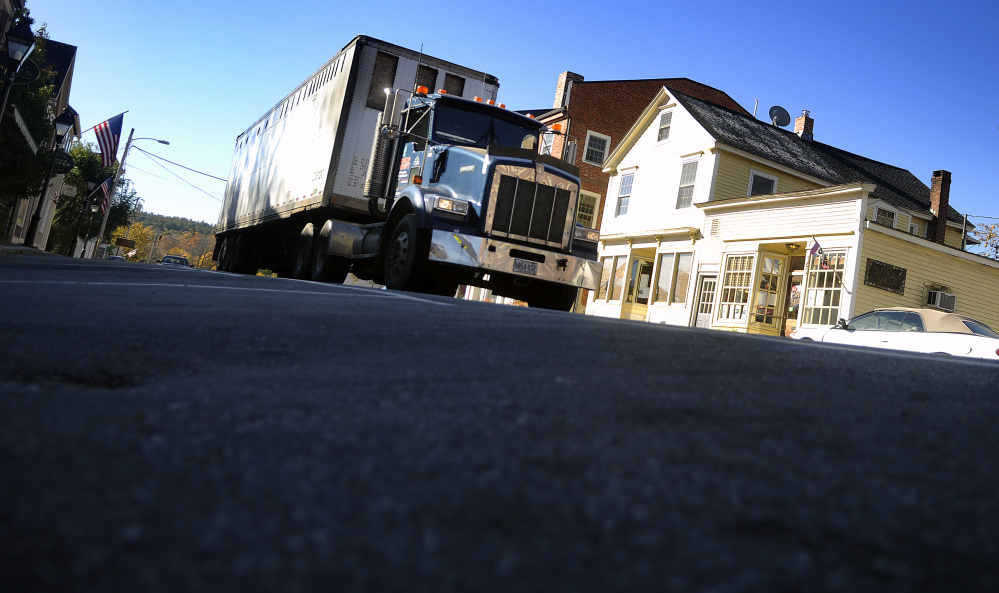The Maine Department of Transportation is hosting another public meeting Thursday night in connection with the Water Street reconstruction project scheduled to begin in Spring 2018.
The meeting will begin at 6 p.m. in the Hall-Dale Elementary School cafeteria on Winthrop Street in Hallowell.
“I expect MaineDOT to unveil more specific plans and commitments for construction and detours,” said Councilor Alan Stearns, chairman of the city’s highway committee. “The committee hasn’t seen those plans, but we’ll need the full support from legislators and businesses to rally behind goals of innovation and financial commitment from MaineDOT.”
In an email to the Kennebec Journal, Stearns said the council will need to have a final vote on a few minor brickwork and streetlight options, but he said those options likely won’t be an issue at Thursday’s meeting.
Stearns said the state concluded that the city can ask Central Maine Power to remove several of the overhead, large intersection lights that won’t be needed because of the planned sidewalk lights.
“That is a nice design breakthrough,” the councilor said.
According to Project Manager Ernie Martin, the meeting is the final public hearing related to the design. Martin hopes to begin advertising the project to contractors in January 2018, and he expects many more meetings about the constructability of the project and the issues that may come up as a result of the work.
“I’m going to throw some stuff out there and see what kind of feedback we get,” Martin said by phone Tuesday.
In April, the Hallowell Highway Committee and transportation department hosted a meeting to unveil the preliminary design plan for the project. Stearns, who has been Hallowell’s driving force behind the project, gave a presentation to more than 50 people outlining the city’s role in the process and some of the concerns associated with a project on such a large scale.
The city is expecting to incur costs of more than $130,000 for drainage work on Central and Union streets, well below the more than $800,000 the state will pay for drainage problems on other streets, including Union and Temple streets.
During the April meeting, Martin said construction would begin April 16, 2018, and end Oct. 19, 2018, with the surface work being completed in June 2019. He said construction work would take place from sunrise to sunset Monday through Friday. The bulk of activity during the 155 working days would take place on Water Street. Martin estimated about 70 working days with one construction crew would be needed to complete the curb-to-curb work on the street.
Martin said that’s still the path and theme, but there have been utilities crews and DOT crews in Hallowell in recent months that have discovered unexpected things underground that may impact the amount of time the project would take. There are drainage concerns that will have to be dealt with, and Martin said the whole project “will be a challenge.”
“We’re trying to plan for all of the issues that may come up, because it’s better to plan for the worst than have an emergency situation,” Martin said. “It’s going to be tough, and it’s going to be frustrating.”
Despite the challenges, Martin said the department is committed to the project and to accommodating as many of the users of the corridor as possible. Business owners, residents, pedestrians and bicyclists are just some of the groups that will be impacted by the work.
“It’s a big (project), and we’ve got a long way to go, but (Water Street) has been begging for this project for a number of years,” Martin said. “We’ve got a unified approach to this project now that the city is on board.”
Stearns said he is optimistic that the transportation department has kept schedule-based contracting incentives on the table to help expedite construction.
Throughout the process, downtown Hallowell business owners and residents have expressed concern over the time line for the work and the construction hours. The effect on local businesses has been a priority for everyone involved in the process, especially the City Council.
The state’s stated goal was to start and finish the work during the 2018 construction season, which Martin said could only be accomplished with a one-way traffic pattern. As was the case in April, the plan for a construction detour includes one-way traffic northbound, while southbound traffic would be rerouted to Second Street.
Last year, nearly 250 people responded to a DOT survey about the project, and more than 86 percent said they preferred a one-way traffic pattern.
Earlier this year curb extensions, or bump-outs, were a hot-button topic when discussing the design on the new Water Street. Urban planner Brian Kent gave a presentation advocating for curb extensions as visually pleasing and as a way to make the heavily trafficked downtown corridor safer for pedestrians and bicyclists.
But adding curb extensions was never seriously considered by the highway committee or council in the years spent working with the DOT designing the project.
“I think we all agree that bump-outs have come and gone,” Stearns said.
Jason Pafundi — 621-5663
Twitter: @jasonpafundiKJ
Send questions/comments to the editors.




Comments are no longer available on this story